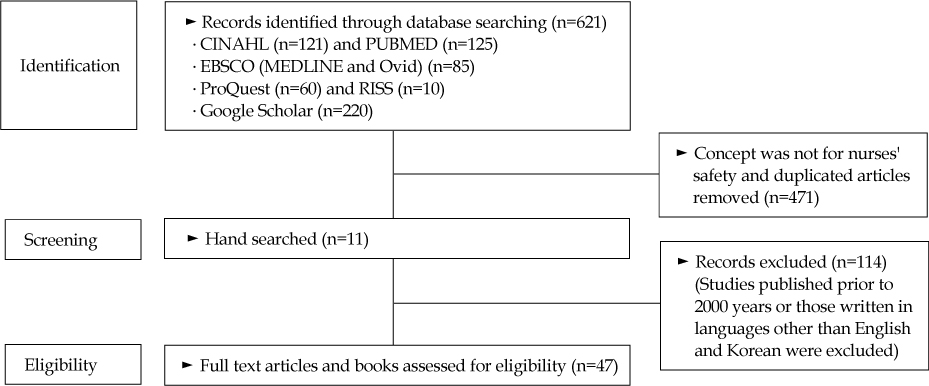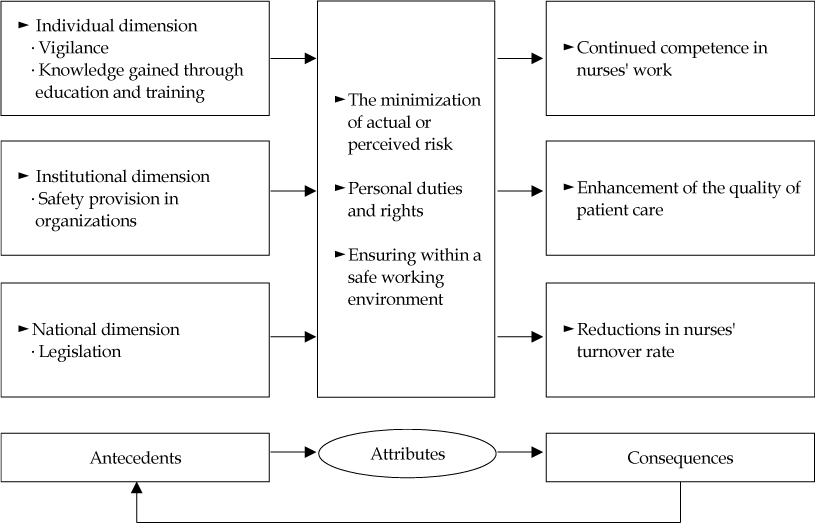J Korean Acad Nurs Adm.
2016 Sep;22(4):406-414. 10.11111/jkana.2016.22.4.406.
Nurses' Safety in the Hospital Environment: Evolutionary Concept Analysis
- Affiliations
-
- 1Department of Nursing, Dong-A University, Korea. enlee@dau.ac.kr
- KMID: 2355218
- DOI: http://doi.org/10.11111/jkana.2016.22.4.406
Abstract
- PURPOSE
The purpose of this study was to analyze the concept of nurses' safety within the context of the hospital environment.
METHODS
We used Rodgers' method of evolutionary concept analysis and reviewed the relevant literature and noted and categorized characteristics that appeared frequently.
RESULTS
Nurses' safety was defined as safe status and safe activity among nurses. Three key defining attributes were identified as: (a) the minimization of actual or perceived risk, (b) personal duties and rights, and (c) ensuring within a safe working environment. Antecedents of nurses' safety were categorized into three dimensions: (a) individual, including vigilance and knowledge gained through education and training; (b) institutional, including safety provision in the organizations; and (c) national, including legislation. The outcomes of nurses' safety included the following: (a) continued competence in nurses' work; (b) enhancement of the quality of patient care; and (c) reductions in nurses' turnover rates.
CONCLUSION
Nurses' safety ensures that qualified nurses are able to continue to perform their duties and provide good patient care. The findings of this study could contribute to future research examining nurses' safety. In addition, appropriate tools must be developed to measure the concept.
Figure
Reference
-
1. Foley M. Caring for those who care: A tribute to nurses and their safety. Online J Issues Nurs. 2004; 9(3):2.2. De Castro AB. Handle with care: The American Nurses Association's campaign to address work-related musculoskeletal disorders. Orthop Nurs. 2006; 25(6):356–365.3. Health and Safety Authority. Working health guidelines of hospital nurses. Seoul: Health and Safety Authority;2012. p. 4–39.4. Kramer M, Schmalenberg C. Confirmation of a healthy work environment. Crit Care Nurse. 2008; 28(2):56–63.5. Walker LO, Avant KC. Strategies for Theory Construction in Nursing. 5th ed. Upper Saddle River, NJ: Prentice Hall;2011. p. 157–159.6. Rodgers BL. Concept analysis: an evolutionary view. In : Rodgers BL, Knafl KA, editors. Concept development in nursing: Foundations, technqiues, and applications. 2nd ed. Philadelphia: Saunders;2000. p. 77–102.7. American Heritage. The American Heritage Dictionary of the English Languages. 5th ed. Boston, MA: Houghton Mifflin Harcourt;2011.8. Leyden AT. A culture of safety: Nurses can take an active role in preventing needlestick injuries. Am J Nurs. 2004; 104(10):104.9. Ulrich B. Nurse safety. Nephrol Nurs J. 2013; 40(5):377.10. Dawes BS. Focusing on the safe, healthy workplace. Association of Operating Room Nurses. AORN J. 2001; 73(1):16–18.11. Flanagan M. Every patient deserves a safe nurse: patient safety cannot be achieved when nurses are not safe. Am J Nurs. 2005; 105(11):112.12. Brinia V, Antonaki E. Health and safety risks, implications and training in hospitals. Ind Commer Train. 2013; 45(7):420–427. DOI: 10.1108/ICT-04-2013-0025.13. Geiger-Brown J, Lipscomb J. The health care work environment and adverse health and safety consequences for nurses. Annu Rev Nurs Res. 2011; 28:191–232. DOI: 10.1891/0739-6686.28.191.14. Trinkoff AM, Geiger-Brown JM, Caruso CC, Lipscomb JA, Johantgen M, Nelson AL. Personal safety for nurses. In : Hughes R, editor. United States, Agency for Healthcare Research Quality. Patient safety and quality: An evidence-based handbook for nurses. AHRQ publication, no. 08-0043. Rockville, MD: Agency for Healthcare Research and Quality, U.S. Dept. of Health and Human Services;2008. p. 473–508. Chapter 39.15. Griffith R. Health and safety in the NHS. Br J Nurs. 2014; 23(2):112–113. DOI: 10.12968/bjon.2014.23.2.112.16. Smith RA. What you don't know can hurt you: Health hazards in the work environment. J Perianesth Nurs. 2009; 24(2):75–80.17. Weaver D. Part 1: contribute to health and safety. Nurs Resid Care. 2011; 13(10):464–468. DOI: 10.12968/nrec.2011.13.10.464.18. Cesario SK. Designing health care environments: Part I. Basic concepts, principles, and issues related to evidence-based design. J Contin Educ Nurs. 2009; 40(6):280–288. DOI: 10.3928/00220124-20090522-09.19. American Nurses Association. Nurses say health and safety concerns play major role in employment decisions [Internet]. 2001. updated Sep 7 2001. Available from: http://www.medscape.com/viewarticle/411358.20. Trim JC, Elliott TS. A review of sharps injuries and preventative strategies. J Hosp Infect. 2003; 53:237–242. DOI: 10.1053/jhin.2002.1378.21. Dolansky MA, Moore SM. Quality and safety education for nurses (QSEN): the key is systems thinking. Online J Issues Nurs. 2013; 18(3):1.22. Nelson A, Baptiste AS. Evidence-based practices for safe patient handling and movement. Online J Issues Nurs. 2004; 9(3):4.23. Sedlak CA. Nurse safety: have we addressed the risks? Online J Issues Nurs. 2004; 9(3):1.24. Kohn LT, Corrigan JM, Donaldson MS. To Err is human: Building a safer health system. Institute of Medicine. Washington, D.C.: National Academy Press;2000.25. Baumann A. Canadian health services research foundation. Commitment and care: the benefits of a healthy workplace for nurses, their patients and the system. Ottawa: Canadian Health Services Research Foundation;2001.26. De Castro AB. 'Hierarchy of controls': Providing a framework for addressing workplace hazards. Am J Nurs. 2003; 103(12):104.27. Clarke SP, Rockett JL, Sloane DM, Aiken LH. Organizational climate, staffing, and safety equipment as predictors of needlestick injuries and near-misses in hospital nurses. Am J Infect Control. 2002; 30(4):207–216. DOI: 10.1067/mic.2002.123392.28. Stone PW, Clarke SP, Cimiotti J, Correa-de-Araujo R. Nurses' working conditions: implications for infectious disease. Emerg Infect Dis. 2004; 10(11):1984–1989. DOI: 10.3201/eid1011.040253.29. Val Palumbo M, Rambur B, McIntosh B, Naud S. Registered nurses' perceptions of health and safety related to their intention to leave. AAOHN J. 2010; 58(3):95–103. DOI: 10.3928/08910162-20100216-01.30. Clarke SP. Hospital work environments, nurse characteristics, and sharps injuries. Am J Infect Control. 2007; 35(5):302–309. DOI: 10.1016/j.ajic.2006.07.014.
- Full Text Links
- Actions
-
Cited
- CITED
-
- Close
- Share
- Similar articles
-
- Evolutionary Psychiatry I-Concept of Evolutionary Psychology and Evolutionary Psychopathology
- The Influence of Professional Self-Concept and Patient Safety Culture on Burnout among Nurses in a Cancer Hospital
- Effects of Nursing Work Environment and Self-Efficacy of General Hospital Nurses on Medical Safety Competence in Korea
- Quality of Pediatric Nursing Care: Concept Analysis
- Evolutionary Concept Analysis of Resilience in People with Mental Disabilities



